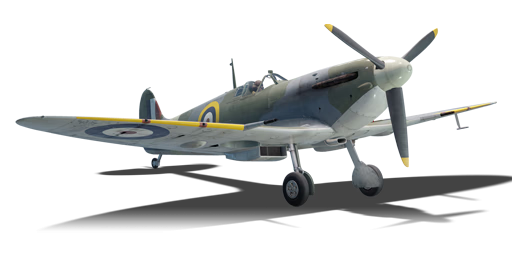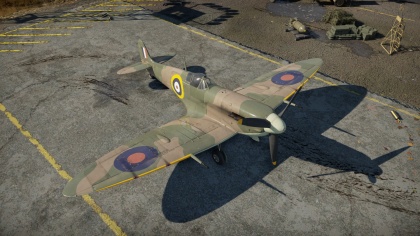Spitfire Mk IIb
Contents
| This page is about the aircraft Spitfire Mk IIb. For other uses, see Spitfire (Disambiguation) |
Description
The Spitfire Mk IIb is a Rank II British fighter
with a battle rating of 3.7 (AB/RB) and 3.0 (SB). This aircraft has been in the game since the start of the Open Beta Test prior to Update 1.29.
The Spitfire is a good turn fighter, and should be used in this way most of the time. Note, however, that with the two 20mm cannons, the Spitfire Mk IIb can also be used as a reasonable Boom and Zoom fighter, with less results. It is recommended to use AP-I ammo for the Spitfire MkIIb's 7.7mm machine guns, and the HEF-I ammo for the 20mm cannons to do maximum air damage. It is also advisable to make sure that you conserve your ammo and only fire when you have a clear target, as you'll find you'll run out of ammo very quickly.
General info
Flight Performance
| Characteristics | |||||||
|---|---|---|---|---|---|---|---|
| Stock | |||||||
| Max Speed (km/h at 4,572 m) |
Max altitude (meters) |
Turn time (seconds) |
Rate of climb (meters/second) |
Take-off run (meters) | |||
| AB | RB | AB | RB | AB | RB | ||
| 545 | 535 | 10000 | 16.2 | 16.5 | 14.1 | 16.1 | 300 |
| Upgraded | |||||||
| Max Speed (km/h at 4,572 m) |
Max altitude (meters) | Turn time (seconds) | Rate of climb (meters/second) |
Take-off run (meters) | |||
| AB | RB | AB | RB | AB | RB | ||
| 599 | 571 | 10000 | 14.7 | 15.1 | 27.2 | 19.4 | 300 |
Details
| Features | ||||
|---|---|---|---|---|
| Combat flap | Take-off flap | Landing flap | Air brakes | Arrestor gear |
| X | X | ✓ | X | X |
| Limits | ||||
|---|---|---|---|---|
| Wing-break speed (km/h) |
Gear limit (km/h) |
Combat flap (km/h) |
Max Static G | |
| + | - | |||
| 760 | 270 | 290 | ~14 | ~8 |
| Optimal velocities | |||
|---|---|---|---|
| Ailerons (km/h) |
Rudder (km/h) |
Elevators (km/h) |
Radiator (km/h) |
| < 321 | < 400 | < 465 | > 260 |
| Compressor (RB/SB) | ||
|---|---|---|
| Setting 1 | ||
| Optimal altitude | 100% Engine power | WEP Engine power |
| 4,490 m | 1,140 hp | 1,311 hp |
Survivability and armour
- 38 mm Bulletproof glass in cockpit front.
- 4 mm Steel plate in pilot's seat
- 6-7 mm Steel plate behind the pilot.
- Critical components located at the front of aircraft (fuel, pilot, engine, controls)
- More fuel tanks located in wings near the fuselage
Armaments
Offensive armament
The Spitfire Mk IIb is armed with:
- 2 x 20 mm Hispano Mk.I cannon, wing-mounted (60 rpg = 120 total)
- 4 x 7.7 mm Browning machine gun, wing-mounted (350 rpg = 1,400 total)
Usage in the battles
Manual Engine Control
| MEC elements | ||||||
|---|---|---|---|---|---|---|
| Mixer | Pitch | Radiator | Supercharger | Turbocharger | ||
| Oil | Water | Type | ||||
| Controllable | Not controllable | Not controllable | Not controllable | Separate | Not ontrollable | Not controllable |
Modules
| Tier | Flight performance | Survivability | Weaponry | ||
|---|---|---|---|---|---|
| I | Fuselage Repair | Radiator | |||
| II | Compressor | Airframe | |||
| III | Wings Repair | Engine | |||
| IV | Engine Injection | Cover | |||
Pros and cons
Pros:
- Absolutely amazing turn capabilities, even at low speeds.
- One of the best turners.
- Superior climb capabilities.
- Relatively good armament with a 20 mm and 7.7 mm combination arrangement.
- Very easy aircraft to control.
- Good acceleration.
Cons:
- 7.7 mm machine guns have low damage and stopping power.
- Cannons have average ammo count for this rank.
- Wings overload easily at high speeds.
- Hispano Mk.I 20 mm has a tendency to jam under continuous firing.
- Low dive speed limit.
- Poor roll rate, especially at high speed.
- Only position for flaps is in landing mode.
History
The Supermarine Spitfire was a British fighter which served with various nations from the late 1930s up into the 1950s. It was a single-engine, all-metal, low-wing monoplane with retractable landing gear. Various modifications served as fighters, interceptors, high-altitude fighters, fighter-bombers and reconnaissance aircraft. A total of some 20,300 Spitfires of all types were built during the war, including two-seater trainers.
In the summer of 1939, an early Spitfire Mk I was fitted with the new Rolls Royce Merlin XII engine, which had a higher output of 1175 HP and was fitted with a Coffman engine starter instead of the previous Merlin’s electrical starter system. This, combined with the Rotol variable pitch propeller which had been used on many Spitfire Mk Is would now form the powerplant of the new Spitfire Mk II, although some production models used the De Havilland propeller. The Mk II was some 6-7 mph faster than the later Spitfire Mk I, but still slower than the original Spitfires before a series of modifications increased the aircraft’s weight. As with the Mk I, the Spitfire Mk II was produced with either eight machine guns as the Spitfire Mk IIA, or two 20mm cannon and four machine guns as the Mk IIb. The earlier problems with cannon fitted to the Mk IB had now been solved by introducing a belt feed system to the weapon to replace the earlier drum, turning the cannon on its side and fitting a blister on the wing to house the new mechanism.
920 Spitfire Mk IIs entered service; 750 Mk IIA and 170 MK IIB, although fighters used in the air-sea rescue role were later designated Mk IIC. The Spitfire II quickly replaced the Spitfire I, with the older variant being relegated to use in Operational Training Units. By April 1941, RAF Fighter Command had completed re-equipping with the Mk II, although this too would soon be replaced by the Mk V.
Media
An excellent addition to the article will be video guides, as well as screenshots from the game and photos.
Read also
Links to the articles on the War Thunder Wiki that you think will be useful for the reader, for example,
- reference to the series of the aircraft;
- links to approximate analogues of other nations and research trees.
Sources
Paste links to sources and external resources, such as:
- topic on the official game forum;
- page on aircraft encyclopedia;
- other literature.





